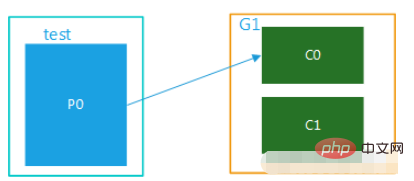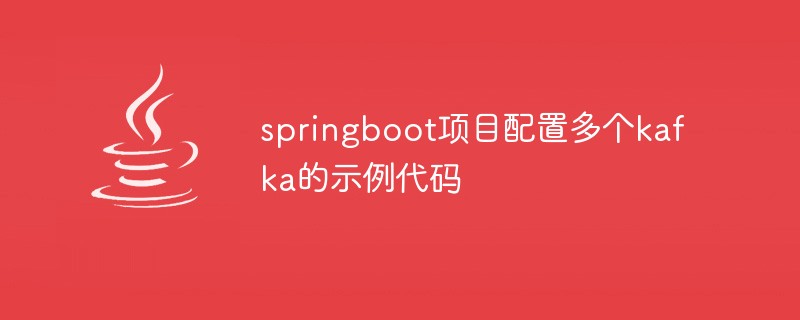 Java
Java javaTutorial
javaTutorial How to use Java to develop a real-time stream processing application based on Kafka
How to use Java to develop a real-time stream processing application based on Kafka
How to use Java to develop a real-time stream processing application based on Kafka
Kafka is a distributed stream processing platform that is widely used in large-scale real-time data processing scenarios. Using Kafka enables real-time stream processing with high throughput, scalability, and reliability. This article will introduce how to use Java language to develop a real-time stream processing application based on Kafka and provide specific code examples.
- Environment preparation
Before starting development, you need to prepare the following environment:
- Install Java Development Kit (JDK): Make sure your The appropriate version of JDK is already installed on the computer.
- Install Apache Kafka: Apache Kafka can be downloaded and installed from the official website.
-
Create a Kafka topic: In Kafka, data is published and subscribed through topics. Create a topic named "test_topic" using the following command:
kafka-topics.sh --create --bootstrap-server localhost:9092 --replication-factor 1 --partitions 1 --topic test_topic
- Add Kafka dependency
Before you start writing code, you need to add Kafka dependencies in Java Add Kafka dependencies to the project. In a Maven project, dependencies can be added by adding the following code block in the pom. A Java code example of sending a message using a Kafka consumer:
<dependency>
<groupId>org.apache.kafka</groupId>
<artifactId>kafka-clients</artifactId>
<version>0.10.0.0</version>
</dependency>- Consumer code example
The following is a Java code example of using a Kafka consumer to receive a message:
import org.apache.kafka.clients.producer.KafkaProducer;
import org.apache.kafka.clients.producer.ProducerRecord;
import java.util.Properties;
public class KafkaProducerExample {
public static void main(String[] args) {
// 设置Kafka服务器的地址和端口
String bootstrapServers = "localhost:9092";
// 设置消息的key和value的序列化方式
Properties props = new Properties();
props.put("bootstrap.servers", bootstrapServers);
props.put("key.serializer", "org.apache.kafka.common.serialization.StringSerializer");
props.put("value.serializer", "org.apache.kafka.common.serialization.StringSerializer");
// 创建Kafka生产者
KafkaProducer<String, String> producer = new KafkaProducer<>(props);
// 发送消息到主题
String topic = "test_topic";
String message = "Hello Kafka!";
ProducerRecord<String, String> record = new ProducerRecord<>(topic, message);
producer.send(record);
// 关闭生产者
producer.close();
}
}- By running the above code example, you can publish and receive messages in Kafka. In the producer example, we send messages to a topic named "test_topic". In the consumer example, we consume messages from the "test_topic" topic and print them out.
- To sum up, this article introduces how to use Java to develop a real-time stream processing application based on Kafka. By studying the above code examples, you can understand how to use Kafka producers and consumers in Java projects. Of course, there are more configurations and functions available in actual applications, but here is just a simple getting started example. Hope this article helps you!
The above is the detailed content of How to use Java to develop a real-time stream processing application based on Kafka. For more information, please follow other related articles on the PHP Chinese website!
 springboot+kafka中@KafkaListener动态指定多个topic怎么实现May 20, 2023 pm 08:58 PM
springboot+kafka中@KafkaListener动态指定多个topic怎么实现May 20, 2023 pm 08:58 PM说明本项目为springboot+kafak的整合项目,故其用了springboot中对kafak的消费注解@KafkaListener首先,application.properties中配置用逗号隔开的多个topic。方法:利用Spring的SpEl表达式,将topics配置为:@KafkaListener(topics=“#{’${topics}’.split(’,’)}”)运行程序,console打印的效果如下
 如何使用PHP和Kafka实现实时股票分析Jun 28, 2023 am 10:04 AM
如何使用PHP和Kafka实现实时股票分析Jun 28, 2023 am 10:04 AM随着互联网和科技的发展,数字化投资已成为人们越来越关注的话题。很多投资者不断探索和研究投资策略,希望能够获得更高的投资回报率。股票交易中,实时的股票分析对决策非常重要,其中使用Kafka实时消息队列和PHP技术实现更是一种高效且实用的手段。一、Kafka介绍Kafka是由LinkedIn公司开发的一个高吞吐量的分布式发布、订阅消息系统。Kafka的主要特点是
 SpringBoot怎么集成Kafka配置工具类May 12, 2023 pm 09:58 PM
SpringBoot怎么集成Kafka配置工具类May 12, 2023 pm 09:58 PMspring-kafka是基于java版的kafkaclient与spring的集成,提供了KafkaTemplate,封装了各种方法,方便操作,它封装了apache的kafka-client,不需要再导入client依赖org.springframework.kafkaspring-kafkaYML配置kafka:#bootstrap-servers:server1:9092,server2:9093#kafka开发地址,#生产者配置producer:#Kafka提供的序列化和反序列化类key
 kafka可视化工具对比分析:如何选择最合适的工具?Jan 05, 2024 pm 12:15 PM
kafka可视化工具对比分析:如何选择最合适的工具?Jan 05, 2024 pm 12:15 PM如何选择合适的Kafka可视化工具?五款工具对比分析引言:Kafka是一种高性能、高吞吐量的分布式消息队列系统,被广泛应用于大数据领域。随着Kafka的流行,越来越多的企业和开发者需要一个可视化工具来方便地监控和管理Kafka集群。本文将介绍五款常用的Kafka可视化工具,并对比它们的特点和功能,帮助读者选择适合自己需求的工具。一、KafkaManager
 go-zero与Kafka+Avro的实践:构建高性能的交互式数据处理系统Jun 23, 2023 am 09:04 AM
go-zero与Kafka+Avro的实践:构建高性能的交互式数据处理系统Jun 23, 2023 am 09:04 AM近年来,随着大数据的兴起和活跃的开源社区,越来越多的企业开始寻找高性能的交互式数据处理系统来满足日益增长的数据需求。在这场技术升级的浪潮中,go-zero和Kafka+Avro被越来越多的企业所关注和采用。go-zero是一款基于Golang语言开发的微服务框架,具有高性能、易用、易扩展、易维护等特点,旨在帮助企业快速构建高效的微服务应用系统。它的快速成长得
 springboot项目配置多个kafka的示例代码May 14, 2023 pm 12:28 PM
springboot项目配置多个kafka的示例代码May 14, 2023 pm 12:28 PM1.spring-kafkaorg.springframework.kafkaspring-kafka1.3.5.RELEASE2.配置文件相关信息kafka.bootstrap-servers=localhost:9092kafka.consumer.group.id=20230321#可以并发消费的线程数(通常与partition数量一致)kafka.consumer.concurrency=10kafka.consumer.enable.auto.commit=falsekafka.boo
 从面试角度一文学完 KafkaAug 24, 2023 pm 03:22 PM
从面试角度一文学完 KafkaAug 24, 2023 pm 03:22 PMKafka 是一个优秀的分布式消息中间件,许多系统中都会使用到 Kafka 来做消息通信。对分布式消息系统的了解和使用几乎成为一个后台开发人员必备的技能。
 go-zero与Kafka的应用实践:构建高并发、高可靠性的消息系统Jun 23, 2023 am 09:40 AM
go-zero与Kafka的应用实践:构建高并发、高可靠性的消息系统Jun 23, 2023 am 09:40 AM随着互联网的不断发展,对于消息系统的需求也越来越高。在构建高并发、高可靠性的消息系统中,go-zero和Kafka是两个非常好的选择。go-zero是一个基于Go语言的微服务框架,通过简单易用、高性能、可扩展等特点,在很多领域被广泛应用。Kafka是一个开源的分布式流媒体平台,具有高可靠性、高吞吐量、易拓展等特点,在处理大规模数据流和实时数据管道方面得到广泛


Hot AI Tools

Undresser.AI Undress
AI-powered app for creating realistic nude photos

AI Clothes Remover
Online AI tool for removing clothes from photos.

Undress AI Tool
Undress images for free

Clothoff.io
AI clothes remover

AI Hentai Generator
Generate AI Hentai for free.

Hot Article

Hot Tools

SublimeText3 English version
Recommended: Win version, supports code prompts!

Safe Exam Browser
Safe Exam Browser is a secure browser environment for taking online exams securely. This software turns any computer into a secure workstation. It controls access to any utility and prevents students from using unauthorized resources.

Zend Studio 13.0.1
Powerful PHP integrated development environment

DVWA
Damn Vulnerable Web App (DVWA) is a PHP/MySQL web application that is very vulnerable. Its main goals are to be an aid for security professionals to test their skills and tools in a legal environment, to help web developers better understand the process of securing web applications, and to help teachers/students teach/learn in a classroom environment Web application security. The goal of DVWA is to practice some of the most common web vulnerabilities through a simple and straightforward interface, with varying degrees of difficulty. Please note that this software

mPDF
mPDF is a PHP library that can generate PDF files from UTF-8 encoded HTML. The original author, Ian Back, wrote mPDF to output PDF files "on the fly" from his website and handle different languages. It is slower than original scripts like HTML2FPDF and produces larger files when using Unicode fonts, but supports CSS styles etc. and has a lot of enhancements. Supports almost all languages, including RTL (Arabic and Hebrew) and CJK (Chinese, Japanese and Korean). Supports nested block-level elements (such as P, DIV),





